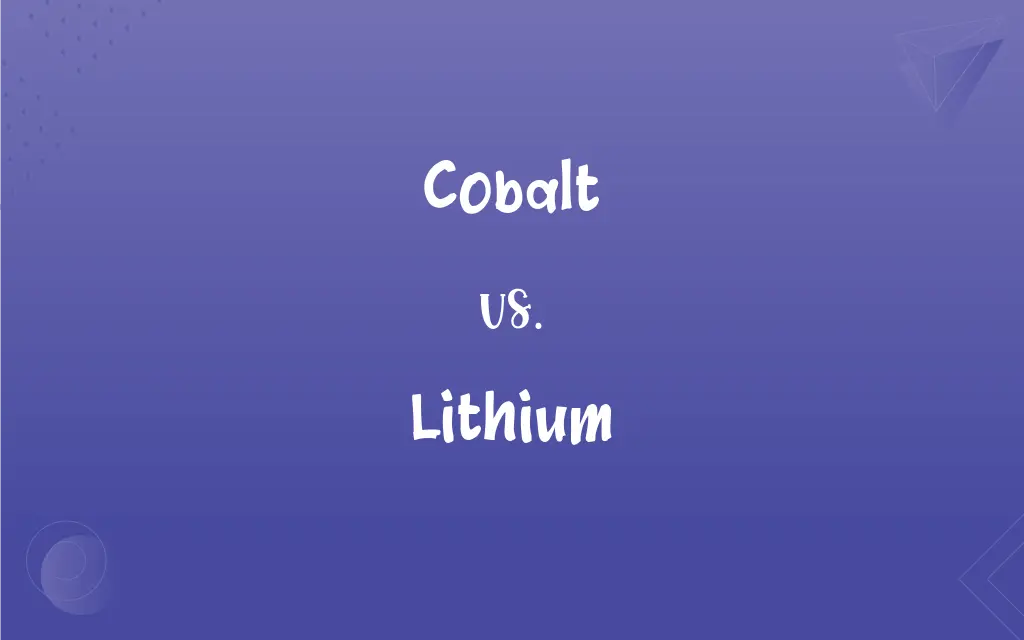Cobalt vs. Lithium: What's the Difference?
Edited by Harlon Moss || By Janet White || Published on December 20, 2023
Cobalt is a hard, lustrous, silver-gray metal used in alloys and batteries, while lithium is a soft, silvery-white metal, crucial in batteries and psychiatric medication.

Key Differences
Cobalt, a transition metal, is known for its strength and high melting point, making it valuable in alloys. In contrast, lithium, an alkali metal, is the lightest metal and has a significantly lower melting point, used primarily in batteries and mental health treatment.
Cobalt is essential in the production of high-performance alloys, and its radioactive isotopes are used in medical treatment. However, lithium’s role in rechargeable batteries for electronics and electric vehicles highlights its importance in energy storage technology.
Environmental and ethical concerns surround cobalt mining, often linked to regions with challenging labor conditions. Lithium mining, while also environmentally impactful, is central to the transition to renewable energy, given its use in battery technology.
Cobalt's magnetic properties are crucial in producing powerful magnets. Lithium, due to its reactivity and lightness, is vital in applications ranging from aerospace to medication for bipolar disorder.
The market dynamics for cobalt and lithium differ, with cobalt's price often influenced by geopolitical factors, whereas lithium's demand is driven by the global push for electric vehicles and renewable energy storage.
ADVERTISEMENT
Comparison Chart
Atomic Number
27
3
Physical Properties
Hard, lustrous, high melting point
Soft, silvery-white, low melting point
Primary Uses
Alloys, batteries, medical isotopes
Batteries, medication, metal alloys
Environmental Concerns
Ethical issues in mining
Environmental impact of mining
Market Influences
Geopolitical factors
Renewable energy and EV technology
ADVERTISEMENT
Cobalt and Lithium Definitions
Cobalt
It's known for its blue pigments in glass and ceramics.
Cobalt blue glass is prized for its vivid color.
Lithium
Lithium is a soft, silver-white metal, the lightest solid element.
Lithium is an essential component in lightweight batteries.
Cobalt
Cobalt alloys are essential in aerospace and tool manufacturing.
Cobalt-based alloys are used in turbine blades.
Lithium
It's used in psychiatric medication for bipolar disorder.
Lithium carbonate is a common treatment for mood stabilization.
Cobalt
It's used in medical radiotherapy isotopes.
Cobalt-60 is an important isotope in cancer treatment.
Lithium
Lithium is a key element in rechargeable batteries.
Electric vehicles rely on lithium-ion batteries for power.
Cobalt
Cobalt is a chemical element with symbol Co and atomic number 27.
Cobalt is used to produce superalloys for jet engines.
Lithium
It has the lowest density of all metals.
Lithium's lightness makes it ideal for aerospace applications.
Cobalt
Cobalt is a component in lithium-ion batteries.
Cobalt enhances the energy density of smartphone batteries.
Lithium
A soft, silvery, highly reactive element that is an alkali metal and is used as a heat transfer medium, in thermonuclear weapons, and in batteries, lubricants, various alloys, ceramics, and optical glass. Atomic number 3; atomic weight 6.941; melting point 180.5°C; boiling point 1,342°C; specific gravity 0.534; valence 1. See Periodic Table.
Cobalt
A hard, brittle metallic element, found associated with nickel, silver, lead, copper, and iron ores and resembling nickel and iron in appearance. It is used chiefly for magnetic alloys, high-temperature alloys, and in the form of its salts for blue glass and ceramic pigments. Atomic number 27; atomic weight 58.9332; melting point 1,495°C; boiling point 2,927°C; specific gravity 8.9; valence 2, 3. See Periodic Table.
Lithium
Any of several salts of lithium, especially lithium carbonate.
Cobalt
A chemical element (symbol Co) with an atomic number of 27: a hard, lustrous, silver-gray metal.
Lithium
(uncountable) The simplest alkali metal, the lightest solid element, and the third lightest chemical element (symbol Li) with an atomic number of 3. It is a soft, silvery metal.
Cobalt
Cobalt blue.
Lithium
(countable) A single atom of this element.
Cobalt
A tough, lustrous, reddish white metal of the iron group, not easily fusible, and somewhat magnetic. Atomic weight 59.1. Symbol Co.
Lithium
Lithium carbonate or other preparations of lithium metal used to treat manic depression and bipolar disorders.
Cobalt
A commercial name of a crude arsenic used as fly poison.
Lithium
A lithium battery.
Cobalt
A hard ferromagnetic silver-white bivalent or trivalent metallic element; a trace element in plant and animal nutrition
Lithium
A metallic element of the alkaline group, occurring in several minerals, as petalite, spodumene, lepidolite, triphylite, etc., and otherwise widely disseminated, though in small quantities.
Lithium
A soft silver-white univalent element of the alkali metal group; the lightest metal known; occurs in several minerals
Lithium
Lithium compounds are used in ceramics and glass.
Lithium helps improve the strength and durability of glass products.
FAQs
What is cobalt used for?
Cobalt is used in alloys, batteries, pigments, and medical isotopes.
Where is cobalt found?
Cobalt is primarily mined in the Democratic Republic of Congo and other parts of the world.
Is cobalt magnetic?
Yes, cobalt is one of the few metals that are magnetic.
Is lithium reactive?
Yes, lithium is highly reactive, especially with water.
Can lithium be harmful?
In large doses, lithium can be toxic, but it's generally safe in controlled applications.
What is lithium's primary use?
Lithium is primarily used in rechargeable batteries and psychiatric medication.
Can cobalt be recycled?
Yes, cobalt can be recycled from used batteries and other products.
How do cobalt and lithium affect electronics?
They are vital in the production of high-performance batteries for electronics.
What are the environmental concerns with cobalt?
The main concerns are ethical mining practices and ecological impact.
How does lithium benefit renewable energy?
Lithium batteries are key in storing energy from renewable sources.
Are cobalt and lithium recyclable?
Yes, both elements are recyclable, especially from batteries.
How does the price of cobalt and lithium affect the market?
Fluctuating prices can significantly impact the cost of electronics and electric vehicles.
Where is lithium found?
Lithium is extracted from mineral deposits and salt flats, mainly in Australia, Chile, and China.
Do cobalt and lithium have any medicinal uses?
Cobalt is used in medical isotopes, while lithium is used in psychiatric medication.
What are the risks associated with cobalt and lithium mining?
Risks include environmental damage and, in the case of cobalt, ethical labor concerns.
What role do cobalt and lithium play in the automotive industry?
They are crucial in the production of batteries for electric vehicles.
Can cobalt and lithium be used interchangeably?
No, they have different properties and specific uses in various applications.
Are there any technological advancements involving cobalt and lithium?
Yes, ongoing research aims to improve efficiency and sustainability in their usage.
How do cobalt and lithium contribute to sustainability?
They are essential in the development of clean energy technologies.
Are there alternatives to cobalt and lithium in batteries?
Research is ongoing for alternatives, but currently, they are key battery components.
About Author
Written by
Janet WhiteJanet White has been an esteemed writer and blogger for Difference Wiki. Holding a Master's degree in Science and Medical Journalism from the prestigious Boston University, she has consistently demonstrated her expertise and passion for her field. When she's not immersed in her work, Janet relishes her time exercising, delving into a good book, and cherishing moments with friends and family.
Edited by
Harlon MossHarlon is a seasoned quality moderator and accomplished content writer for Difference Wiki. An alumnus of the prestigious University of California, he earned his degree in Computer Science. Leveraging his academic background, Harlon brings a meticulous and informed perspective to his work, ensuring content accuracy and excellence.







































































